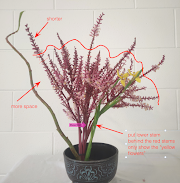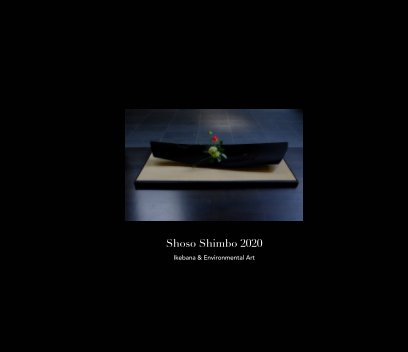Line 1 - Task, 5 Sep 2020
Topic: Line 1
Ikebana Aesthetics Program - Zoom Ikebana Dojo
Learn about the four Ikebana elements online in September & October 2020. Beginners welcome. 日本からのご参加歓迎いたします。
When:
Session 1, 4:00 - 4:30 PM, 5 September 2020 (Melbourne Time)
Session 2, 4:00 - 4:30 PM, 12 September 2020 (Melbourne Time)
Who can Join: Anyone, regardless of ikebana school, stage of learning or country of residence. Beginners welcome. You must be familiar with Zoom. Sessions will be conducted in English.
How Many Participants: Up to 6 for each session
How Much: Aus $40 for 4 sessions (Line, Form, Space & Colour). Pay by bank transfer (within Australia, type your name in reference) or credit card or Paypal. You can pay $10 to join just one session.
Overview
The first topic in the study of design elements in ikebana is line. Line is the crucial element in ikebana that distinguishes ikebana from other types of flower arrangements (See Conder, 1891).
A line is a series of connected points. It can be straight, curved, horizontal, vertical, diagonal, dotted, broken, thick or thin. In ikebana you can use lineal materials such as spear grass as line, or you can create line, for instance by removing leaves from a stem. In addition, you can develop skills to curve or straighten materials such as branches, stems, or leaves to create lines you like.
In ikebana, Line is very expressive. Line can make your work energetic, strong, sharp or delicate. Controlling the line element will contribute greatly to the effectiveness of your design and will be the focus of the follow-up study topics Line 2 and Line 3. In these topics you will explore the many functions of line. You will learn the importance and value of asking yourself, “What is the function of this line (these lines) in this ikebana work?”. For more about line in ikebana, refer to a short essay, "Introduction to Ikebana Aesthetics" by Dr Shoso Shimbo (available shortly in English & Japanese).
In this topic - Line 1 - we focus on incorporating straight lines in your design using lineal materials. Let’s find and use naturally straight lines.
Objectives
1. Find straight lines in materials. You don’t need to manipulate materials to create straight lines this time. But you may cut or bend your materials.
2. Make straight line(s) as main feature of your design. You may incorporate curved lines or massed elements as contrast to emphasise straight lines.
3. Arrange straight lines radiantly, suggesting life energy expanding outward. That is one of the most fundamental functions of line in ikebana. Be careful not to use too many lines.
2. Make straight line(s) as main feature of your design. You may incorporate curved lines or massed elements as contrast to emphasise straight lines.
3. Arrange straight lines radiantly, suggesting life energy expanding outward. That is one of the most fundamental functions of line in ikebana. Be careful not to use too many lines.
4. Make your arrangement in moribana style using a kenzan, florist form or other method for easy fixture. (Note: we will focus on nageire style in Line 2 & 3.)
5. Learn how to measure angles in ikebana.
6. Notice the effect of lines. What do lines do to your design? Advanced students may consider the relationship between line and other elements (mass, space, texture). Advanced students may also try this topic using just one type of material.
What You Need
What You Need
1. Secateurs (scissors may be handy too)
2. kenzan or florist foam or wire packed container (see task for Balance 1 for an example)
3. container - any low container may be used including a bowl or cup.
4. Flower/plant materials: (Flower materials are a guide only. You can choose any similar materials as long as you focus on the topic.)
a. five (5) thin long leaves such as bulrush
b. five (5) foliage such as fern
c. five (5) flowers such as ranunculus
2. kenzan or florist foam or wire packed container (see task for Balance 1 for an example)
3. container - any low container may be used including a bowl or cup.
4. Flower/plant materials: (Flower materials are a guide only. You can choose any similar materials as long as you focus on the topic.)
a. five (5) thin long leaves such as bulrush
b. five (5) foliage such as fern
c. five (5) flowers such as ranunculus
d. a few additional flowers (optional)
How to Make It
How to Make It
You will receive Line 1 Session Notes with step-by-step instructions for making your arrangement after your payment. Our free video and the Session Notes will help you make your ikebana work.
How to Apply & Participate
1. Send an application form by 31 August 2020. Please apply early.
2. If your application is accepted, you will receive an email with instruction on how to pay.
1. Send an application form by 31 August 2020. Please apply early.
2. If your application is accepted, you will receive an email with instruction on how to pay.
Please visit our orientation page for more practical advice on how to use Ikebana Dojo.
3. Upon receipt of your payment, we will send you an email of invitation to the session & session notes on how to make our sample work.
4. Do your task.
5. Make your ikebana work before the session. Take a photo of your work (less than 0.5 Meg.) and send to ikebana.dojo@gmail.com at least 24 hours before the session starts if you want detailed feedback.
6. Alternatively, you can share the photo of your work during the session. Find a way to share your file using Zoom.
7. Join the session. Prepare your work and its photo.
8. Enjoy show and tell by other students before and after your own presentation. Group interaction is helpful for your learning. Works by others can inspire you.
9. Share a photo of your work to Ikebana Gallery Facebook Page. See how to apply for Ikebana Gallery Award if you are a student.
10. If you would like to join Zoom Ikebana Dojo again, please visit our pages on Ikebana Aesthetics Program or Special Program.
3. Upon receipt of your payment, we will send you an email of invitation to the session & session notes on how to make our sample work.
4. Do your task.
5. Make your ikebana work before the session. Take a photo of your work (less than 0.5 Meg.) and send to ikebana.dojo@gmail.com at least 24 hours before the session starts if you want detailed feedback.
6. Alternatively, you can share the photo of your work during the session. Find a way to share your file using Zoom.
7. Join the session. Prepare your work and its photo.
8. Enjoy show and tell by other students before and after your own presentation. Group interaction is helpful for your learning. Works by others can inspire you.
9. Share a photo of your work to Ikebana Gallery Facebook Page. See how to apply for Ikebana Gallery Award if you are a student.
10. If you would like to join Zoom Ikebana Dojo again, please visit our pages on Ikebana Aesthetics Program or Special Program.
References
Ikebana Aesthetics Curriculum
生花道場カリキュラム(日本語)
Josiah Conder (1891). The Flowers of Japan and The Art of Floral Arrangement.
Ikebana Aesthetics Curriculum
生花道場カリキュラム(日本語)
Josiah Conder (1891). The Flowers of Japan and The Art of Floral Arrangement.
Samples for Advanced Students

























